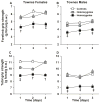Cognitive and behavior deficits in sickle cell mice are associated with profound neuropathologic changes in hippocampus and cerebellum
- PMID: 26462816
- PMCID: PMC4688201
- DOI: 10.1016/j.nbd.2015.10.004
Cognitive and behavior deficits in sickle cell mice are associated with profound neuropathologic changes in hippocampus and cerebellum
Abstract
Strokes are perhaps the most serious complications of sickle cell disease (SCD) and by the fifth decade occur in approximately 25% of patients. While most patients do not develop strokes, mounting evidence indicates that even without brain abnormalities on imaging studies, SCD patients can present profound neurocognitive dysfunction. We sought to evaluate the neurocognitive behavior profile of humanized SCD mice (Townes, BERK) and to identify hematologic and neuropathologic abnormalities associated with the behavioral alterations observed in these mice. Heterozygous and homozygous Townes mice displayed severe cognitive deficits shown by significant delays in spatial learning compared to controls. Homozygous Townes also had increased depression- and anxiety-like behaviors as well as reduced performance on voluntary wheel running compared to controls. Behavior deficits observed in Townes were also seen in BERKs. Interestingly, most deficits in homozygotes were observed in older mice and were associated with worsening anemia. Further, neuropathologic abnormalities including the presence of large bands of dark/pyknotic (shrunken) neurons in CA1 and CA3 fields of hippocampus and evidence of neuronal dropout in cerebellum were present in homozygotes but not control Townes. These observations suggest that cognitive and behavioral deficits in SCD mice mirror those described in SCD patients and that aging, anemia, and profound neuropathologic changes in hippocampus and cerebellum are possible biologic correlates of those deficits. These findings support using SCD mice for studies of cognitive deficits in SCD and point to vulnerable brain areas with susceptibility to neuronal injury in SCD and to mechanisms that potentially underlie those deficits.
Keywords: Anemia; Anxiety; Cerebellum; Depression; Hippocampus; Learning; Memory; Neuronal injury; Pain.
Copyright © 2015 Elsevier Inc. All rights reserved.
Conflict of interest statement
The authors declare that there is no conflict of interest.
Figures








Similar articles
-
Locomotor mal-performance and gait adaptability deficits in sickle cell mice are associated with vascular and white matter abnormalities and oxidative stress in cerebellum.Brain Res. 2020 Nov 1;1746:146968. doi: 10.1016/j.brainres.2020.146968. Epub 2020 Jun 10. Brain Res. 2020. PMID: 32533970 Free PMC article.
-
Sickle cell disease mice have cerebral oxidative stress and vascular and white matter abnormalities.Blood Cells Mol Dis. 2021 Feb;86:102493. doi: 10.1016/j.bcmd.2020.102493. Epub 2020 Sep 4. Blood Cells Mol Dis. 2021. PMID: 32927249 Free PMC article.
-
Sickle cell disease in mice is associated with sensitization of sensory nerve fibers.Exp Biol Med (Maywood). 2015 Jan;240(1):87-98. doi: 10.1177/1535370214544275. Epub 2014 Jul 28. Exp Biol Med (Maywood). 2015. PMID: 25070860 Free PMC article.
-
Cognitive and behavioral function in children with sickle cell disease: a review and discussion of methodological issues.J Pediatr Hematol Oncol. 1998 Sep-Oct;20(5):458-62. doi: 10.1097/00043426-199809000-00009. J Pediatr Hematol Oncol. 1998. PMID: 9787319 Review.
-
Hypoxia and inflammation in children with sickle cell disease: implications for hippocampal functioning and episodic memory.Neuropsychol Rev. 2014 Jun;24(2):252-65. doi: 10.1007/s11065-014-9259-4. Epub 2014 Apr 18. Neuropsychol Rev. 2014. PMID: 24744195 Review.
Cited by
-
Vascular Instability and Neurological Morbidity in Sickle Cell Disease: An Integrative Framework.Front Neurol. 2019 Aug 13;10:871. doi: 10.3389/fneur.2019.00871. eCollection 2019. Front Neurol. 2019. PMID: 31474929 Free PMC article.
-
The platelet NLRP3 inflammasome is upregulated in sickle cell disease via HMGB1/TLR4 and Bruton tyrosine kinase.Blood Adv. 2018 Oct 23;2(20):2672-2680. doi: 10.1182/bloodadvances.2018021709. Blood Adv. 2018. PMID: 30333099 Free PMC article.
-
Carbon monoxide incompletely prevents isoflurane-induced defects in murine neurodevelopment.Neurotoxicol Teratol. 2017 May;61:92-103. doi: 10.1016/j.ntt.2017.01.004. Epub 2017 Jan 26. Neurotoxicol Teratol. 2017. PMID: 28131877 Free PMC article.
-
Predecompression and postdecompression cognitive and affective changes in Chiari malformation type I.J Neurosurg. 2025 Feb 21;143(1):4-12. doi: 10.3171/2024.8.JNS241363. Print 2025 Jul 1. J Neurosurg. 2025. PMID: 39983117
-
Role of age and neuroinflammation in the mechanism of cognitive deficits in sickle cell disease.Exp Biol Med (Maywood). 2021 Jan;246(1):106-120. doi: 10.1177/1535370220958011. Epub 2020 Sep 22. Exp Biol Med (Maywood). 2021. PMID: 32962408 Free PMC article.
References
Publication types
MeSH terms
Substances
Grants and funding
LinkOut - more resources
Full Text Sources
Other Literature Sources
Medical
Molecular Biology Databases
Miscellaneous

